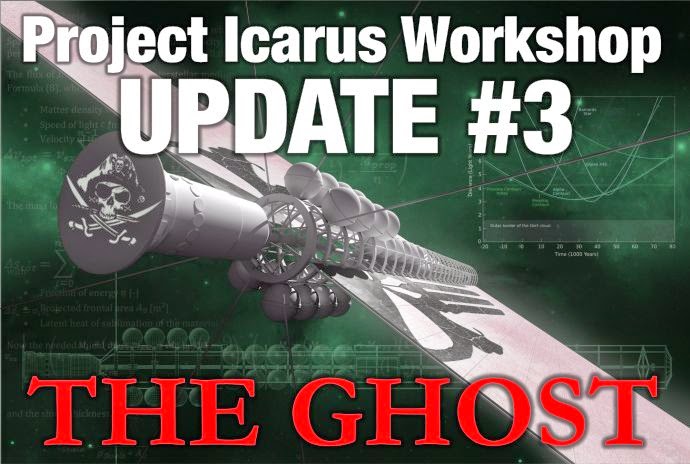Project Icarus had a competition to create interstellar concept designs. The outline parameters were based on the project ToRs (Terms of Reference) for a mainly fusion spacecraft, on a 100 year mission with up to 150 tonnes payload (given the unavoidable size of your typical fusion spacecraft).
The winner was the Ghost Ship.
The Ghost Ship uses one single fusion propulsion stage for acceleration and deceleration. Deceleration is further supported by a magnetic sail system, which uses the drag of interstellar hydrogen acting on a magnetic field which decelerates the spacecraft. The fusion propulsion system is based on Deuterium – Deuterium inertial confinement fusion. Inertial confinement fusion is based on compressing a tiny pellet of fusion fuel by an ignition system, in our case a number of lasers. The fuel is compressed by these very high-power lasers to such a degree that fusion can occur. The team decided to use Deuterium – Deuterium, as Deuterium – Tritium would use large amounts of Tritium, which decays quite rapidly. This means that a prohibitively large amount of Tritium has to be stored on-board of the spacecraft. Deuterium – Helium 3 was discarded due to the difficulties associated with mining Helium 3 from the Moon or the gas giant planets.
The fusion ignition system is based on the fast ignition scheme. The beauty of this ignition scheme lies in the decoupling of compression and ignition of a fuel pellet. Without decoupling, a lot of energy is needed to create fusion conditions within the pellet purely by compression. It is like igniting a rod of dynamite by pinching it. It is possible but you need to pinch it very strongly. What you use instead is a “fuse”: a secondary high-power laser, which pierces the pellet and ignites it. In this way, you get the same amount of energy out of the pellet by using a lot less energy for compression and ignition.
Read more »![]()
The winner was the Ghost Ship.
The Ghost Ship uses one single fusion propulsion stage for acceleration and deceleration. Deceleration is further supported by a magnetic sail system, which uses the drag of interstellar hydrogen acting on a magnetic field which decelerates the spacecraft. The fusion propulsion system is based on Deuterium – Deuterium inertial confinement fusion. Inertial confinement fusion is based on compressing a tiny pellet of fusion fuel by an ignition system, in our case a number of lasers. The fuel is compressed by these very high-power lasers to such a degree that fusion can occur. The team decided to use Deuterium – Deuterium, as Deuterium – Tritium would use large amounts of Tritium, which decays quite rapidly. This means that a prohibitively large amount of Tritium has to be stored on-board of the spacecraft. Deuterium – Helium 3 was discarded due to the difficulties associated with mining Helium 3 from the Moon or the gas giant planets.
The fusion ignition system is based on the fast ignition scheme. The beauty of this ignition scheme lies in the decoupling of compression and ignition of a fuel pellet. Without decoupling, a lot of energy is needed to create fusion conditions within the pellet purely by compression. It is like igniting a rod of dynamite by pinching it. It is possible but you need to pinch it very strongly. What you use instead is a “fuse”: a secondary high-power laser, which pierces the pellet and ignites it. In this way, you get the same amount of energy out of the pellet by using a lot less energy for compression and ignition.
Read more »
